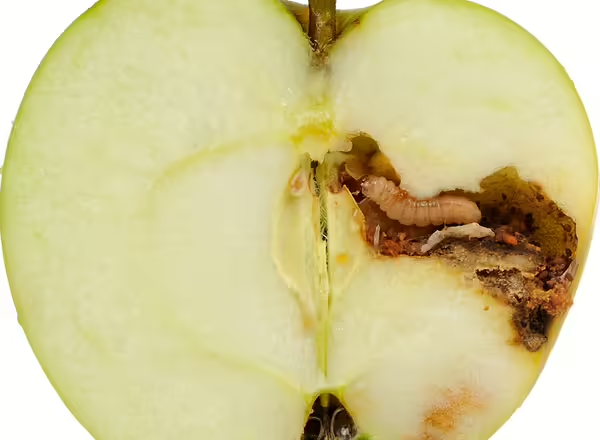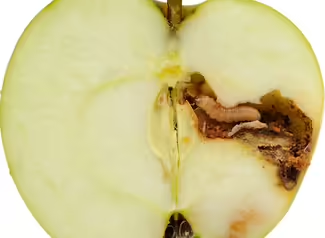The adult apple maggot is a fly, slightly smaller than a house fly, that lays tiny yellow eggs on developing fruit. The eggs hatch into white-to-yellow larvae, which are typical maggots with a narrow, pointed front-end and a blunt, broad rear-end. Full-grown larvae are only 1/4 to 3/8 inch long.

Apple Maggot Habit
Apple maggot is primarily a problem in northern Illinois, feeding on apple and crabapple. Adult flies begin emerging in June from overwintering pupae in the soil, with the bulk of emergence occurring in late June. By the end of August, most adults have emerged, but some may still appear in September. Females deposit eggs just under the fruit skin and eggs hatch in 5-10 days. Larvae tunnel through the fruit flesh and mature after fruit fall. There is usually one generation per year in Illinois, but some areas may have a partial second generation.
Apple Maggot Damage
Pits and dimples form on the apple as a result of egg laying damage, leading to misshapen fruit. Larvae damage the flesh by leaving large brown trails allowing decay to occur. When numerous, the fruit grows extremely dimpled and gnarled, and the flesh is ruined.
Apple Maggot Control
Nonchemical: None. If you have only 1-2 trees and no other host trees are within 300 ft, removing apple maggot infested fruit that has fallen to the ground may help reduce next years' population. Red spheres covered with sticky material placed around the outside of the tree may help reduce apple maggot damage.
Chemical: Sprays to control apple maggot in the northern half of Illinois should be applied through July and August. Contact your county Extension office for current pesticide controls.
